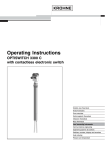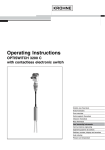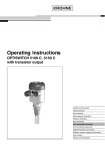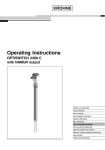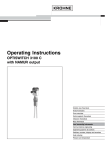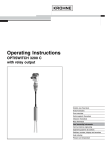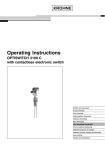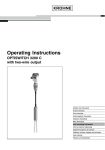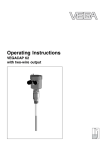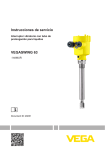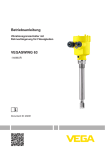Download OPTISWITCH 5200C, 5250C with NAMUR output - BA
Transcript
Operating Instructions OPTISWITCH 5200 C, 5250 C with NAMUR output Contents Contents 1 About this document 1.1 1.2 1.3 2 . . . . . . . . . . . . . . . . . . . . . . . . . . . . . . . . . . . . . . . . . . .. .. .. .. .. .. .. 5 5 5 5 5 6 6 Configuration. . . . . . . Principle of operation . Adjustment . . . . . . . . Storage and transport . . . . . . . . . . . . . . . . . . . . . . . . . . . . . . . . . . . . . . . . . . . . . . . . . . . . . . . . . . . . . . . . . . . . .. .. .. .. 7 7 9 9 General instructions. . . . . . . . . . . . . . . . . . . . . 10 Mounting information . . . . . . . . . . . . . . . . . . . . 12 Preparing the connection . . . . . . . . . . . . . . . . . 16 Connection procedure . . . . . . . . . . . . . . . . . . . 16 Wiring plans, single chamber housing . . . . . . . . 17 General. . . . . . . . . . . . . . . . . . . . . . . . . . . . . . 19 Adjustment elements . . . . . . . . . . . . . . . . . . . . 19 Function chart . . . . . . . . . . . . . . . . . . . . . . . . . 20 Maintenance . . . . . . . . . . . . . . . . . . . . . . . . . . 22 Fault rectification . . . . . . . . . . . . . . . . . . . . . . . 22 Instrument repair . . . . . . . . . . . . . . . . . . . . . . . 23 Dismounting procedure . . . . . . . . . . . . . . . . . . 24 Disposal . . . . . . . . . . . . . . . . . . . . . . . . . . . . . 24 OPTISWITCH 5200 C, 5250 C - with NAMUR output 30434-EN-050622 Dismounting 8.1 8.2 2 . . . . . . . Maintenance and fault rectification 7.1 7.2 7.3 8 . . . . . . . Set up 6.1 6.2 6.3 7 . . . . . . . Connecting to power supply 5.1 5.2 5.3 6 . . . . . . . Mounting 4.1 4.2 5 Authorised personnel . . . . . . . . Appropriate use. . . . . . . . . . . . Warning about misuse . . . . . . . General safety instructions . . . . CE conformity . . . . . . . . . . . . . SIL conformity . . . . . . . . . . . . . Safety information for Ex areas. Product description 3.1 3.2 3.3 3.4 4 4 4 4 For your safety 2.1 2.2 2.3 2.4 2.5 2.6 2.7 3 Function . . . . . . . . . . . . . . . . . . . . . . . . . . . . . Target group . . . . . . . . . . . . . . . . . . . . . . . . . . Symbolism used . . . . . . . . . . . . . . . . . . . . . . . Contents 9 Functional safety 9.1 9.2 9.3 9.4 9.5 9.6 General. . . . . . . . . . . . . . . . . . . . . . . . . . . . . . Planning . . . . . . . . . . . . . . . . . . . . . . . . . . . . . Setup . . . . . . . . . . . . . . . . . . . . . . . . . . . . . . . Reaction during operation and in case of failure. Recurring function test . . . . . . . . . . . . . . . . . . . Safety-related characteristics . . . . . . . . . . . . . . 25 26 28 29 29 30 10 Supplement 30434-EN-050622 10.1 Technical data. . . . . . . . . . . . . . . . . . . . . . . . . 33 10.2 Dimensions . . . . . . . . . . . . . . . . . . . . . . . . . . . 38 10.3 Certificates . . . . . . . . . . . . . . . . . . . . . . . . . . . 40 OPTISWITCH 5200 C, 5250 C - with NAMUR output 3 About this document 1 About this document 1.1 Function This operating instructions manual has all the information you need for quick setup and safe operation of OPTISWITCH 5200 C, 5250 C. Please read this manual before you start setup. 1.2 Target group This operating instructions manual is directed to trained personnel. The contents of this manual should be made available to these personnel and put into practice by them. 1.3 Symbolism used Information, tip, note This symbol indicates helpful additional information. Caution, warning, danger This symbol informs you of a dangerous situation that could occur. Ignoring this cautionary note can impair the person and/ or the instrument. Ex applications This symbol indicates special instructions for Ex applications. l List The dot set in front indicates a list with no implied sequence. à Action This arrow indicates a single action. 1 Sequence Numbers set in front indicate successive steps in a procedure. 30434-EN-050622 4 OPTISWITCH 5200 C, 5250 C - with NAMUR output For your safety 2 For your safety 2.1 Authorised personnel All operations described in this operating instructions manual must be carried out only by trained specialist personnel authorised by the operator. For safety and warranty reasons, any internal work on the instruments must be carried out only by personnel authorised by the manufacturer. 2.2 Appropriate use OPTISWITCH 5200 C, 5250 C is a sensor for level detection. Detailed information on the application range of OPTISWITCH 5200 C, 5250 C is available in chapter Product description. 2.3 Warning about misuse Inappropriate or incorrect use of the instrument can give rise to application-specific hazards, e.g. vessel overfill or damage to system components through incorrect mounting or adjustment. 2.4 General safety instructions OPTISWITCH 5200 C, 5250 C is a high-tech instrument requiring the strict observance of standard regulations and guidelines. The user must take note of the safety instructions in this operating instructions manual, the country-specific installation standards (e.g. the VDE regulations in Germany) as well as all prevailing safety regulations and accident prevention rules. 2.5 CE conformity OPTISWITCH 5200 C, 5250 C is in CE conformity with EMC (89/336/EWG), fulfils the NAMUR recommendation NE 21 and is in CE conformity with NSR (73/23/EWG). 30434-EN-050622 Conformity has been judged acc. to the following standards: l EMC: - Emission EN 61326/A1: 1998 (class B) - Susceptibility EN 61326: 1997/A1: 1998 l NSR: EN 61010-1: 1993 OPTISWITCH 5200 C, 5250 C - with NAMUR output 5 For your safety 2.6 SIL conformity OPTISWITCH 5200 C, 5250 C meets the requirements to the functional safety acc. to IEC 61508/IEC 61511. Further information is available in chapter "Functional safety". 2.7 Safety information for Ex areas Please note the Ex-specific safety information for installation and operation in Ex areas. These safety instructions are part of the operating instructions manual and come with the Exapproved instruments. 30434-EN-050622 6 OPTISWITCH 5200 C, 5250 C - with NAMUR output Product description 3 Product description 3.1 Configuration Scope of delivery The scope of delivery encompasses: l l Components OPTISWITCH 5200 C, 5250 C level sensor Documentation - this operating instructions manual - Ex-specific safety instructions (with Ex versions) and, if necessary, further certificates OPTISWITCH 5200 C, 5250 C consists of the following components: l l l Housing cover Housing with electronics process fitting with tuning fork 1 2 3 Fig. 1 2 3 1: OPTISWITCH 5200 C, 5250 C - with plastic housing Housing cover Housing with electronics Process fitting 30434-EN-050622 3.2 Principle of operation Area of application OPTISWITCH 5200 C, 5250 C is a level sensor with tuning fork for level detection. OPTISWITCH 5200 C, 5250 C - with NAMUR output 7 Product description It is designed for industrial use in all areas of process technology and is used in liquids. Typical applications are overfill and dry run protection. With a tuning fork of only 40 mm length, OPTISWITCH 5200 C, 5250 C can be also mounted, e.g. in pipelines from DN 25. The small tuning fork allows the use in vessels, tanks and pipes. Thanks to its simple and robust measuring system, OPTISWITCH 5200 C, 5250 C is virtually unaffected by the chemical and physical properties of the liquid. It functions also under difficult conditions such as turbulence, air bubbles, foam generation, buildup, strong external vibration or changing products. Fault monitoring The electronics module of OPTISWITCH 5200 C, 5250 C monitors continuously the following criteria via the frequency evaluation: l l l strong corrosion or damage of the tuning fork no vibration line break to the piezo drive If one of these faults is detected or if the power supply fails, the electronics takes on a defined output status (safe condition). OPTISWITCH 5200 C, 5250 C fulfills the requirements of IEC 61508 and 61511 of SIL2 (see Supplement). Physical principle The tuning fork is piezoelectrically energised and vibrates at its mechanical resonance frequency of approx. 1200 Hz. The piezos are fixed mechanically and are hence not subjected to temperature shock limitations. The frequency changes if the tuning fork is covered by the medium. This change is detected by the integrated oscillator and converted into a switching command. Power supply OPTISWITCH 5200 C, 5250 C is a compact instrument, i.e. it can be operated without external evaluation system. The integrated electronics evaluates the level signal and outputs a switching signal. With this switching signal, a connected device can be operated directly (e.g. a warning system, a PLC, a pump etc.). 8 OPTISWITCH 5200 C, 5250 C - with NAMUR output 30434-EN-050622 The exact range of the power supply is stated in the Technical data in the Supplement. Product description 3.3 Adjustment The switching condition of OPTISWITCH 5200 C, 5250 C with plastic housing can be checked when the housing is closed (LED display). In the basic adjustment, products with a density >0.7 g/cm³ (>0.025 lbs/in³) can be detected. The instrument can be adapted if products with lower density should be measured. On the electronics module you will find the following indicating and adjustment elements: l l l l LED for indication of the switching status DIL switch for switching point adaptation Mode switch to select the switching condition (min/max) Simulation key 3.4 Storage and transport Packaging Your instrument was protected by packaging during transport. Its capacity to handle normal loads during transport is assured by a test acc. to DIN 55439. The packaging of standard instruments consists of environment-friendly, recyclable cardboard. In addition, the sensor is provided with a protective cover of ABS. For special versions PE foam or PE foil is also used. Dispose of the packaging material via specialised recycling companies. Storage and transport temperature l 30434-EN-050622 l Storage and transport temperature see Supplement – Technical data – Ambient conditions Relative humidity 20 … 85 % OPTISWITCH 5200 C, 5250 C - with NAMUR output 9 Mounting 4 Mounting 4.1 General instructions Switching point In general, OPTISWITCH 5200 C, 5250 C can be mounted in any position. The instrument must be mounted in any position. The instrument must be mounted in such a way that the tuning fork is at the height of the requested switching point. The tuning fork has lateral markings (notches), marking the switching point with vertical mounting. The switching point refers to water with the basic setting of the sensitivity switch >=0.7 g/cm³ (>=0.025 lbs/in³). When mounting OPTISWITCH 5200 C, 5250 C, make sure that this marking is at the height of the requested switching point. Keep in mind that the switching point of the instrument is shifted if the medium has a density other than water - water =1.0 g/cm³ (=0.036 lbs/in³). For products <0.7 g/cm³ (<0.025 lbs/in³) and >0.5 g/cm³ (>0.018 lbs/in³) the density switch must be set to >=0.5 g/cm³. 2 1 4 3 10 2: Vertical mounting Switching point approx. 13 mm (ca. 0.51 in) Switching point with lower density Switching point with higher density Switching point approx. 27 mm (approx. 1.06 in) OPTISWITCH 5200 C, 5250 C - with NAMUR output 30434-EN-050622 Fig. 1 2 3 4 Mounting 1 Fig. 3: Horizontal mounting 1 Switching point 2 1 Fig. 4: Horizontal mounting (recommended installation location - particularly for adhesive products) 1 Switching point 2 Marking with screwed version on top - with flange versions directed to the flange holes Moisture Use the recommended cable (see chapter "Connecting to power supply") and tighten the cable entry. 30434-EN-050622 You can give your OPTISWITCH 5200 C, 5250 C additional protection against moisture penetration by leading the connection cable downward in front of the cable entry. Rain and condensation water can thus drain off. This applies mainly to mounting outdoors, in areas where moisture is expected (e.g. by cleaning processes) or on cooled or heated vessels. Fig. 5: Measures against moisture penetration OPTISWITCH 5200 C, 5250 C - with NAMUR output 11 Mounting Transport Do not hold OPTISWITCH 5200 C, 5250 C on the tuning fork. Particularly with flange or tube versions, the tuning fork can be damaged by the instrument weight. Transport enamelled and ECTFE coated instruments very carefully and avoid touching the tuning fork. Remove the protective cover just before mounting. Pressure/Vacuum The process fitting must be sealed if there is gauge or low pressure in the vessel. Before use, check if the seal material is resistant against the measured product and the process temperature. Handling The vibrating level switch is a measuring instrument and must be treated accordingly. Bending the vibrating element will destroy the instrument. Warning: The housing must not be used to screw the instrument in! Applying tightening force to the housing can damage its internal mechanical components. To screw in, use the hexagon above the thread. 4.2 Mounting information Welding the socket OPTISWITCH 5200 C, 5250 C has a defined thread starting point. This means that every OPTISWITCH 5200 C, 5250 C is in the same fork position after being screwed in. Remove therefore the supplied seal from the thread of OPTISWITCH 5200 C, 5250 C. This seal is not required when using a welded socket with O-ring in front. Keep in mind that this welded socket is not suitable for coated instrument versions (e.g. enamel). 12 OPTISWITCH 5200 C, 5250 C - with NAMUR output 30434-EN-050622 Screw OPTISWITCH 5200 C, 5250 C completely into the welded socket. The later position can be determined already before welding. Mark the appropriate position of the welded socket. Before welding, unscrew OPTISWITCH 5200 C, 5250 C and remove the rubber ring from the welded socket. The welded socket has a marking (notch). Weld the socket with the notch facing upward, or in case of pipelines, aligned with the direction of flow. Mounting 1 Fig. 6: Marking on the welded socket 1 Marking Adhesive products In case of horizontal mounting in adhesive and viscous products, the surfaces of the tuning fork should be vertical in order to reduce buildup on the tuning fork. On the screwed version you will find a marking on the hexagon. With this, you can check the position of the tuning fork when screwing it in. When the hexagon touches the seal, the thread can be still turned by approx. half a turn. This is sufficient to reach the recommended installation position. With flange versions, the fork is directed to the flange holes. In case of adhesive and viscous products, the tuning fork should protrude into the vessel to avoid buildup. Therefore sockets for flanges and mounting bosses should be avoided with horizontal mounting. Inflowing medium If OPTISWITCH 5200 C, 5250 C is mounted in the filling stream, unwanted switching signals can be generated. Mount OPTISWITCH 5200 C, 5250 C at a location in the vessel where no disturbing influence from e.g. filling openings, agitators, etc. can occur. 30434-EN-050622 This applies particularly to instrument types with long extension tube. OPTISWITCH 5200 C, 5250 C - with NAMUR output 13 Mounting Fig. 7: Inflowing medium Flow If there is movement within the product, the tuning fork of OPTISWITCH 5200 C, 5250 C should be mounted in such a way that the surfaces of the fork are parallel to the product movement. Agitators Due to agitators, vibrations or similar, the level switch can be subjected to strong lateral forces. For this reason, do not use an overly long extension tube for OPTISWITCH 5200 C, 5250 C, but check if you can mount an OPTISWITCH 5100 C, 5150 C level switch on the side of the vessel in horizontal position. Extreme vibrations from the system side, e.g. by agitators or turbulence in the vessel, e.g. by fluidization can cause the extension tube of OPTISWITCH 5200 C, 5250 C to vibrate. This will cause increased stress on the upper weld joint. Should a longer tube version be necessary, you can provide a suitable straining or fastening directly above the tuning fork to fasten the extension tube. This measure applies particularly to applications in Ex areas category 1G or WHG. Make sure that the tube is not bent by this measure. 30434-EN-050622 14 OPTISWITCH 5200 C, 5250 C - with NAMUR output Mounting Fig. 8: Lateral straining of OPTISWITCH 5200 C, 5250 C Instruments with enamel coating should be treated very carefully and shocks should be avoided. Unpack OPTISWITCH 5200 C, 5250 C directly before installation. Insert OPTISWITCH 5200 C, 5250 C carefully into the vessel opening and avoid touching any sharp vessel parts. 30434-EN-050622 Enamel coating OPTISWITCH 5200 C, 5250 C - with NAMUR output 15 Connecting to power supply 5 Connecting to power supply 5.1 Preparing the connection Note safety instructions Always observe the following safety instructions: l Connect only in the complete absence of line voltage Take note of safety instructions for Ex applications In hazardous areas you should take note of the appropriate regulations, conformity and type approval certificates of the sensors and power supply units. Select power supply Connect the power supply acc. to the following diagrams. Take note of the general installation regulations. As a rule, connect OPTISWITCH 5200 C, 5250 C to vessel ground (PA), or in case of plastic vessels, to the next ground potential. On the side of the instrument housing there is a ground terminal between the cable entries. This connection serves to drain off electrostatic charges. In Ex applications, the installation regulations for hazardous areas must be given priority. The data for power supply are stated in the Technical data in the Supplement. Select connection cable OPTISWITCH 5200 C, 5250 C is connected with standard cable with round wire cross section. An outer cable diameter of 5 … 9 mm (0.2 … 0.35 in) ensures the seal effect of the cable entry. If cable with a different diameter or wire cross section is used, exchange the seal or use an appropriate cable connection. In hazardous areas, only use approved cable connections for OPTISWITCH 5200 C, 5250 C. Select connection cable for Ex applications Take note of the corresponding installation regulations for Ex applications. 5.2 Connection procedure With Ex instruments the housing cover may be opened only if no explosive atmosphere is present. 16 1 Unscrew the housing cover 2 Loosen compression nut of the cable entry OPTISWITCH 5200 C, 5250 C - with NAMUR output 30434-EN-050622 Proceed as follows: Connecting to power supply 3 Remove approx. 10 cm (4 in) of the cable mantle, strip approx. 1 cm (0.4 in) insulation from the ends of the individual wires 4 Insert the cable into the sensor through the cable entry 5 Open the terminals with a screwdriver 6 Insert the wire ends into the open terminals according to the wiring plan 7 Tighten the terminals with a screwdriver 8 Check the hold of the wires in the terminals by lightly pulling on them 9 Tighten the compression nut of the cable entry, the seal ring must completely encircle the cable 10 Screw the housing cover back on The electrical connection is finished. 5.3 Wiring plans, single chamber housing The following illustrations apply to the non-Ex as well as to the EEx d version. Housing overview 4 4 1 2 3 9: Material versions, single chamber housing Plastic (not with EEx d) Aluminium Stainless steel (not with EEx d) Filter element for pressure compensation (not with EEx d) 30434-EN-050622 Fig. 1 2 3 4 4 OPTISWITCH 5200 C, 5250 C - with NAMUR output 17 Connecting to power supply Electronics and connection compartment SW E60N 1 NAMUR (IEC 60947-5-6) + Simul. 6 5 Fig. 1 2 3 4 5 6 Wiring plan max. 0,5 g / cm3 min. 0,7 g / cm3 2 3 1 2 4 10: Electronics and connection compartment, single chamber housing LED display DIL switch for mode adjustment DIL switch for switching point adaptation Ground terminal Simulation key Terminals For connection to an amplifier acc. to NAMUR (IEC 60947-5-6, EN 50227). For further information see Technical data in the Supplement. - + 1 2 - + Fig. 11: Wiring plan, single chamber housing 30434-EN-050622 18 OPTISWITCH 5200 C, 5250 C - with NAMUR output Set up 6 Set up 6.1 General The numbers in brackets refer to the following illustrations. Function/Configuration The switching condition of the electronics can be checked with plastic housing and closed housing cover (LED display). In the basic adjustment, products with a density >0.7 g/cm³ (>0.025 lbs/in³) can be detected. In liquids with lower density, you must set the switch to >0.5 g/cm³ (>0.018 lbs/in³). On the electronics module you will find the following indicating and adjustment elements: l l l l LED display (1) DIL switch for characteristics reversal - min/max (2) DIL switch for sensitivity adjustment (3) Simulation key (4) Note: For test purposes, immerse the tuning fork of OPTISWITCH 5200 C, 5250 C always in liquids. Do not test the function of OPTISWITCH 5200 C, 5250 C with the hand. This can damage the sensor. 6.2 Adjustment elements 30434-EN-050622 1 2 1 2 3 4 Fig. 1 2 3 4 12: Oscillator SW E 60 N - NAMUR output LED display DIL switch for characteristics reversal DIL switch for switching point adaptation Simulation key OPTISWITCH 5200 C, 5250 C - with NAMUR output 19 Set up LED display (1) Single-colour diode for indication of the switching condition. l l l Characteristics reversal (2) red = High current >= 2.2 mA dark = Low current <= 1 mA red (flashing) = Failure <= 1 mA The characteristics reversal can be carried out with the DIL switch. You can choose between falling characteristics (switch position max.) and rising characteristics (switch position min.). You can have the requested current outputted. Modes l l min. - rising characteristics (High current when immersed) max. – falling characteristics (Low current when immersed) The NAMUR output can be switched over to falling or rising characteristics (see also Function chart). For applications acc. to WHG, the DIL switch must be set to position max. Sensitivity adjustment (3) With this DIL switch (3) you can set the switching point to liquids, having a density between 0.5 and 0.7 g/cm³ (0.018 0.025 lbs/in³). In the basic adjustment, liquids with a density of >0.7 g/cm³ (0.025 lbs/in³) can be detected. In products with lower density, you must set the switch to >0,5 g/cm³ (0.018 lbs/ in³). The specifications for the position of the switching point relate the water - density value 1.0 g/cm³ (0.036 lbs/in³). In products with another density, the switching point shifts depending on the density and installation in direction of the housing or tuning fork end. Simulation key (4) The simulation key is lowered on the upper side of the oscillator. Push the simulation key with a suitable object (screwdriver, pen, etc.). When the key is pushed, line break between sensor and processing unit is simulated. The LED on the sensor extinguishes. The measuring system must signal failure and take on safe condition when the key is pushed. Keep in mind that the connected instruments are activated as long as the key is pushed. By doing this, you can check the correct function of the measuring system. The following chart provides an overview of the switching conditions depending on the adjusted mode and level. 20 OPTISWITCH 5200 C, 5250 C - with NAMUR output 30434-EN-050622 6.3 Function chart Set up Note: Select the mode setting on the NAMUR amplifier in such a way that the switching output takes on safe condition if there is a fault signal (I <= 1.0 mA). Level Signal current sensor Falling characteristics max. >= 2.2 mA Falling characteristics max. <= 1.0 mA Rising characteristics min. >= 2.2 mA Rising characteristics min. <= 1.0 mA Failure any Control lamp <= 1.0 mA 30434-EN-050622 flashes OPTISWITCH 5200 C, 5250 C - with NAMUR output 21 Maintenance and fault rectification 7 Maintenance and fault rectification 7.1 Maintenance When used as directed in normal operation, OPTISWITCH 5200 C, 5250 C is completely maintenance-free. 7.2 Fault rectification Checking the switching signal ? OPTISWITCH 5200 C, 5250 C signals "covered" when the vibrating element is not submerged (overfill protection) ? OPTISWITCH 5200 C, 5250 C signals "uncovered" when the vibrating element is submerged (dry run protection) l Supply voltage too low à Check the power supply l Electronics defective à Push the mode switch. If the instrument then changes the mode, the instrument may be mechanically damaged. Should the switching function in the correct mode still be faulty, return the instrument for repair. à Push the mode switch. If the instrument then does not change the mode, the oscillator may be defective. Exchange the oscillator. l Unfavourable installation location à Mount the instrument at a location where no dead zones or air bubbles can form in the vessel. l Wrong mode selected à Set the correct mode on the mode switch (overfill protection; dry run protection). Wiring should be carried out acc. to the quiescent current principle. ? LED flashes red l Failure on the electronics 22 OPTISWITCH 5200 C, 5250 C - with NAMUR output 30434-EN-050622 à Exchanging the electronics Maintenance and fault rectification ? LED flashes red l instrument defective à exchange instrument or return it for repair 7.3 Instrument repair If a repair is necessary, please proceed as follows: You can download a return form from our Internet homepage http://www.krohne-mar.com/fileadmin/media-lounge/PDFDownload/Specimen_e.pdf. By doing this you help us carry out the repair quickly and without having to call back for needed information. l l 30434-EN-050622 l Print and fill out one form per instrument Clean the instrument and pack it damage-proof Attach the completed form and possibly also a safety data sheet to the instrument. OPTISWITCH 5200 C, 5250 C - with NAMUR output 23 Dismounting 8 Dismounting 8.1 Dismounting procedure Warning: Before dismounting, be aware of dangerous process conditions such as e.g. pressure in the vessel, high temperatures, corrosive or toxic products etc. Take note of chapters "Mounting" and "Connecting to power supply" and carry out the listed steps in reverse order. With Ex instruments the housing cover may be opened only if no explosive atmosphere is present. 8.2 Disposal OPTISWITCH 5200 C, 5250 C consists of materials which can be recycled by specialised recycling companies. We have purposely designed the electronic modules to be easily separable. Mark the instrument as scrap and dispose of it according to government regulations (electronic scrap ordinance, …). Materials: see "Technical data" If you cannot dispose of the instrument properly, please contact us about disposal methods or return. 30434-EN-050622 24 OPTISWITCH 5200 C, 5250 C - with NAMUR output Functional safety 9 Functional safety 9.1 General Validity This safety manual applies to measuring systems consisting of OPTISWITCH 5200 C, 5250 C vibrating level switches and integrated oscillator SWE60N. Note: For OPTISWITCH 5200 C, 5250 C with enamelled fork, oscillator SWE60NEx.E or SWE60NEx.E1 is used. Area of application The measuring system can be used for level detection of liquids which meet the specific requirements of the safety technology, e.g.: l l Mode for overfill protection Mode for dry run protection The measuring system is qualified in both modes to meet the following requirement degree acc. to IEC 61508-2/IEC 61511: l l Safety function The safety function of this measuring system is the detection and signalling of the condition of the vibration element. The safe condition depends on the mode: l l Relevant standards SIL2 with architecture 1oo1D (single channel) SIL3 with architecture 1oo2D (double-channel/redundant) l IEC 61508-1, -2, -4 - Functional safety of electrical/electronic/programmable electronic systems IEC 61511-1 - Functional safety – safety instrumented systems for the process industry sector – Part 1: Framework, definitions, system, hardware and software requirements 30434-EN-050622 l Overfill protection: condition "covered" Dry run protection: condition "uncovered" OPTISWITCH 5200 C, 5250 C - with NAMUR output 25 Functional safety Safety requirements The failure limit values for a safety function, depending on the SIL class (of IEC 61508-1, 7.6.2) Safety integrity level Low demand mode SIL High demand or continuous mode PFDavg -5 PFH 4 -4 ≥10 up to <10 ≥10 up to <10-8 3 ≥10-4 up to <10-3 ≥10-8 up to <10-7 -3 -9 2 ≥10 -2 ≥10-7 up to <10-6 1 ≥10-2 up to <10-1 ≥10-6 up to <10-5 up to <10 Safety integrity of the hardware for safety-relating subsystems of type A (IEC 61508-2, 7.4.3) Safe failure fraction Hardware fault tolerance SFF HFT = 0 HFT = 1 HFT = 2 < 60 % SIL 1 SIL 2 SIL 3 60 % up to < 90 % SIL 2 SIL 3 SIL 4 90 % up to < 99 % SIL 3 SIL 4 SIL 4 ≥ 99 % SIL 3 SIL 4 SIL 4 9.2 Planning General instructions and restrictions l l l l The measuring system must be used acc. to the application The application-specific limits must be maintained and the specifications must not be exceeded. The fault tolerance time of the complete system must be higher than the reaction time of the measuring system It must be used only in products to which the materials of the vibrating system are sufficiently chemically resistant. In min. operation also avoid: l l Assumptions 26 For the implementation of FMEDA (Failure Mode, Effects and Diagnostics Analysis) the following assumptions form the basis: OPTISWITCH 5200 C, 5250 C - with NAMUR output 30434-EN-050622 l Buildup on the vibrating system Solids in the measured product >5 mm (>0.2 in) Foam generation with a density >0.5 g/cm³ (>0.018 lbs/in³) Functional safety l l l l l l l l l Low demand mode Failure rates are constant, wear of the mechanical parts is not taken into account Failure rates of external power supplies are not included Multiple errors are not taken into account The average ambient temperature during the operating time is +40°C (104°F) The environmental conditions correspond to an average industrial environment The lifetime of the components is around 8 to 12 years (IEC 61508-2, 7.4.7.4, remark 3) The processing unit can interpret "fail low" and "fail high" failures as interferences and output a suitable fault signal The repair time (exchange of the meas. system) after a failsafe error is eight hours (MTTR = 8 h) In the mode with the lowest demand rate, the reaction time of a connected control and processing unit to dangerous detectable errors is max. 1 hour. If the demand rate is only once a year, then the measuring system can be used as safety-relevant subsystem in "low demand mode" (IEC 61508-4, 3.5.12). If the ratio of the internal diagnostics test rate of the measuring system to the demand rate exceeds the value 100, the measuring system can be treated in the way it is executing a safety function in the mode with low demand rate (IEC 61508-2, 7.4.3.2.5). Corresponding characteristics is the value PFDavg (average Probability of dangerous Failure on Demand). It is dependent on the test interval TProof between the function tests of the protective function. Numbers see paragraph "Safety-technical characteristics". High demand mode If the "low demand mode" does not apply, the measuring system must be used as safety-relevant subsystem in "high demand" (IEC 61508-4, 3.5.12). The fault tolerance time of the complete system must be higher than the sum of the reaction times or the diagnostics test periods of all components in the safety chain. 30434-EN-050622 Corresponding characteristics is the value PFH (failure rate). Numbers see paragraph "Safety-technical characteristics". Safe condition and fault description The safe condition depends on the mode and is stated in the following chart: OPTISWITCH 5200 C, 5250 C - with NAMUR output 27 Functional safety The characteristics min/max must be set acc. to the mode (see Function chart). Safe condition Output current in safe condition Overfill protection Dry run protection "covered" "uncovered" 0.4 … 1 mA 0.4 … 1 mA Failure current "fail low" < 0.4 mA < 0.4 mA Failure current "fail high" > 6.5 mA > 6.5 mA A fail-safe failure (safe failure) exists if the measuring system changes to the defined safe condition or to the failure mode without demand of the process. A dangerous undetected failure exists if the measuring system does neither go to the defined safe condition when required by the process nor to the failure mode. Configuration of the processing unit If the measuring system delivers output currents of "fail low" or "fail high", this can be due to a failure. The processing unit must therefore interpret such currents as failure and output a suitable fault signal. If this is not the case, the appropriate shares of the failure rates must be assigned to the dangerous failures. Therefore the stated values in chapter "Safety-relevant characteristics" can deteriorate. The processing unit must correspond to the SIL level of the measuring chain. The adjustment of the mode on the NAMUR amplifier acc. to IEC 60947-5-6 must be selected in such a way that its switching condition takes on safe condition if there is an input current < 1.2 mA. 9.3 Setup Mounting and installation OPTISWITCH 5200 C, 5250 C - with NAMUR output 30434-EN-050622 28 The prevailing plant conditions influence the safety of the measuring system. Therefore note the mounting and installation instructions of the appropriate operating instructions manual. Mainly important is the correct setting of the mode (A/ B). Functional safety The switching point of the measuring system must be adapted depending on the density limits in the operating instructions manual. 9.4 Reaction during operation and in case of failure l l l l l l The adjustment elements must not be modified during operation. In case of modifications during operation, you have to take note of the safety functions. Occurring fault signals are described in the appropriate operating instructions manual. In case of detected failures or fault signals, the entire measuring system must be switched out of service and the process held in a safe condition by means of other measures. An electronics exchange is easily possible and described in the operating instructions manual. If due to the detected failure, the electronics or the complete sensor is interchanged, the manufacturer must be informed (incl. a fault description). 9.5 Recurring function test The recurring function test serves to reveal potential dangerous errors that are otherwise not discernible. The function of the measuring system must be checked at adequate intervals. The operator is responsible for choosing the type of test and the intervals in the stated time frame. The time frame depends on the PFDavg value acc. to the chart and diagram in section "Safety-related characteristics". With high demand rate, a recurring function test is not requested in IEC 61508. The function of the measuring system is proven by the frequent use of the system. In double channel architectures it is useful to proof the redundancy by recurring function tests in appropriate intervals. 30434-EN-050622 The test must be carried out in a way that verifies the flawless operation of the safety functions in conjunction with all system components. This is ensured by a controlled reaching of the response height during filling. If filling up to the response height is not possible, then a response of the measuring system must be triggered by a suitable simulation of the level or the physical effect. OPTISWITCH 5200 C, 5250 C - with NAMUR output 29 Functional safety The methods and procedures used during the tests must be stated and their suitability must be specified. The tests must be documented. If the function test proves negative, the entire measuring system must be switched out of service and the process held in a safe condition by means of other measures. In the double channel architecture 1oo2D this applies separately to both channels. 9.6 Safety-related characteristics The failure rates of the electronics and the vibrating systems are determined by an FMEDA acc. to IEC 61508. These calculations are based on component failure rates acc. to SN 29500. All numerical values refer to an average ambient temperature during the operating time of +40°C (104°F). The calculations are also based on the specifications stated in chapter "Planning". Overfill protection Dry run protection Mode switch is set to A λsd 9 FIT λsu 203 FIT safe detected failure (1 FIT = failure/109h) safe undetected failure λdd 9 FIT dangerous detected failure λdu 43 FIT dangerous undetected failure SFF > 83 % Safe Failure Fraction Mode switch is set to B λsd 9 FIT safe detected failure λsu 202 FIT λdd 9 FIT dangerous detected failure λdu 45 FIT dangerous undetected failure SFF > 83 % Safe Failure Fraction safe undetected failure General data MTBF = MTTF + MTTR max. useful life of the measuring system for the safety function 30 1.5 sec 3.4x106h approx. 10 years OPTISWITCH 5200 C, 5250 C - with NAMUR output 30434-EN-050622 TReaction Failure reaction time Functional safety Single channel architecture SIL2 (Safety Integrity Level) HFT = 0 (Hardware Fault Tolerance) Architecture 1oo1D – Overfill protection Architecture 1oo1D – Dry run protection Mode switch is set to A PFDavg TProof = 1 year TProof = 5 years TProof = 10 years < 0.019 x 10-2 < 0.094 x 10-2 < 0.190 x 10-2 PFH [1/h] < 0.043 x 10-6 Mode switch is set to B PFDavg TProof = 1 year TProof = 5 years TProof = 10 years < 0.020 x 10-2 < 0.099 x 10-2 < 0.200 x 10-2 PFH [1/h] < 0.045 x 10-6 Double channel architecture SIL3 (Safety Integrity Level) HFT = 1 (Hardware Fault Tolerance) Here you see an example how the measuring system in double channel architecture can be used in an application with demand rate SIL3. A Common Cause Factor of beta = 10 % (worst case) is taken into account. If the instruments are used in another (multiple channel) architecture, the values must be calculated for the selected application by means of the above failure rates. Mode switch is set to A PFDavg TProof = 1 year TProof = 5 years TProof = 10 years < 0.019 x 10-3 < 0.094 x 10-3 < 0.190 x 10-3 PFH [1/h] < 0.053 x 10-7 30434-EN-050622 Architecture 1oo2D – Overfill protection OPTISWITCH 5200 C, 5250 C - with NAMUR output 31 Functional safety Architecture 1oo2D – Dry run protection Time-dependent process of PFDavg Mode switch is set to B PFDavg TProof = 1 year TProof = 5 years TProof = 10 years < 0.020 x 10-3 < 0.099 x 10-3 < 0.200 x 10-3 PFH [1/h] < 0.054 x 10-7 The time-dependent process of PFDavg reacts in the time period up to 10 years virtually linear to the operating time. The above values only apply to the TProof interval, after which a recurring function test must be carried out. 4 PFDavg 3 2 1 1 Fig. 1 2 3 4 13: Time-dependent process of PFDavg1) PFDavg = 0 PFDavg after 1 year PFDavg after 5 years PFDavg after 10 years 1) Numbers see in the above charts. 10 TProof OPTISWITCH 5200 C, 5250 C - with NAMUR output 30434-EN-050622 32 5 Supplement 10 Supplement 10.1 Technical data General data Material 316L corresponds to 1.4404 or 1.4435 Materials, wetted parts - Process fitting – thread 316L; 2.4602 (Hastelloy C4) - Process fitting – Flange 316L; 316L with Hastelloy C4 plated; enamelled steel; 316L with ECTFE coating; 316L with PFA coating - Process seal Klingersil C-4400 - Tuning fork 316L/2.4610 (Hastelloy C4) - Extension tube ø 21.3 mm (ø 0.84 in) 316L; 2.4610 (Hastelloy C4); 2.4610 (Hastelloy C4) enamelled; 316L with ECTFE coating; 316L with PFA coating Materials, non-wetted parts - Housing plastic PBT (Polyester), Alu-die casting powder-coated, stainless steel 316L - Seal ring between housing and housing cover NBR (stainless steel housing), silicone (Alu/ plastic housing) - waveguide in the housing cover PMMA (Makrolon) - Ground terminal 316L - temperature adapter (option) 316L - gastight leadthrough (option) 316L/glass Lengths - 316L, 2.4610 (Hastelloy C4) 80 … 6000 mm (3 … 236 in) - 80 … 1500 mm (3 … 59 in) 2.4610 (Hastelloy C4) enamelled - 1.4435 (316L) ECTFE coated 80 … 3000 mm (3 … 118 in) - 1.4435 (316L) PFA coated 80 … 3000 mm (3 … 118 in) Weights - Plastic housing 760 g (27 oz) Aluminium housing 1170 g (41 oz) - Stainless steel housing 1530 g (54 oz) - Tube extension approx. 110 g/m (1.2 oz/ft) 30434-EN-050622 - OPTISWITCH 5200 C, 5250 C - with NAMUR output 33 Supplement Layer thickness - enamel 0.8 mm (0.03 in) - ECTFE 0.5 mm (0.02 in) - PFA 0.5 mm (0.02 in) Surface quality - Standard Ra approx. 3 µm (approx. 1.18-4 in) - Ra <0.8 µm (<3.15-5 in) Hygienic version 3A (OPTISWITCH 5250 C) Process fittings - Thread G¾A, ¾ NPT, G1A, 1 NPT - flanges DIN from DN 25, ANSI from 1" - hygienic fittings bolting DN 40 PN 40, Tri-Clamp 1", Tri-Clamp 1½" PN 10, cone DN 25 PN 40, Tuchenhagen Varivent DN 50 PN 10 Coatings - ECTFE approx. 0.5 … 0.8 mm (approx. 0.02 … 0.03 in) - PFA approx. 0.3 … 0.5 mm (approx. 0.01 … 0.02 in) - enamel approx. 0.8 mm (approx. 0.03 in) High voltage test (enamel) gastight leadthrough (option) - leakage rate max. 5 KV - pressure resistance PN 64 - hygienic fittings bolting DN 40 PN 40, Tri-Clamp 1", Tri-Clamp 1½" PN 10, cone DN 25 PN 40, Tuchenhagen Varivent DN 50 PN 10 <10-6 mbar l/s Output variable Output Current consumption - falling characteristics two-wire NAMUR output - rising characteristics <=1.0 mA uncovered/>=2.2 mA covered - Fault signal <=1.0 mA >=2.2 mA uncovered/<=1.0 mA covered 30434-EN-050622 34 OPTISWITCH 5200 C, 5250 C - with NAMUR output Supplement Necessary processing system NAMUR processing system acc. to IEC 60947-5-6 (EN 50 227/DIN 19234) Modes (NAMUR output adjustable to falling or rising characteristics) - min rising characteristics (High current when immersed) - max falling characteristics (Low current when immersed) Accuracy Hysteresis Integration time Frequency approx. 2 mm (0.08 in) with vertical installation approx. 500 ms approx. 1200 Hz Ambient conditions Ambient temperature on the housing Storage and transport temperature -40 … +70°C (-40 … +158°F) -40 … +80°C (-40 … +176°F) Process conditions Parameter Process pressure OPTISWITCH 5200 C, 5250 C of 316L/ Hastelloy C4 (2.4610) Process temperature (thread or flange temperature) with temperature adapter (option) - OPTISWITCH 5200 C, 5250 C of 316L/Hastelloy C4 level of liquids -1 … 64 bar (-14.5 … 938 psi) depending on the process fitting, e.g. flange -50 … +150°C (-58 … +302°F) -50 … +250°C (-58 … +482°F) OPTISWITCH 5200 C, 5250 C enamelled -50 … +200°C (-58 … +392°F) - OPTISWITCH 5200 C, 5250 C with ECTFE coating -50 … +150°C (-58 … +302°F) - OPTISWITCH 5200 C, 5250 C with PFA coating -50 … +150°C (-58 … +302°F) 30434-EN-050622 - OPTISWITCH 5200 C, 5250 C - with NAMUR output 35 Supplement 2 3 70˚C (158˚F) 40˚C (104˚F) -50˚C (-58˚F) 1 0˚C (32˚F) 50˚C (122˚F) 100˚C (212˚F) 150˚C (302˚F) 200˚C (392˚F) 250˚C (482˚F) -40˚C (-40˚F) Fig. 1 2 3 14: Ambient temperature – Product temperature Product temperature Ambient temperature Temperature range with temperature adapter Viscosity - dynamic 0.1 … 10,000 mPa s (requirement: with density 1) 0.7 … 2.5 g/cm³ (0.025 … 0.09 lbs/in³); 0.5 … 2.5 g/cm³ (0.018 … 0.09 lbs/in³) by switching over Density Electromechanical data Cable entry/plug 2) - Single chamber housing l or: l 1x cable entry M20x1.5 (cable-ø 5 … 9 mm), 1x blind stopper M20x1.5 1x closing cap ½ NPT, 1x blind stopper ½ NPT or: l Screw terminals 1x plug depending on the version, 1x blind stopper M20x1.5 for wire cross section up to 1.5 mm² (0.0023 in²) Adjustment elements Mode switch - min - rising characteristics (High current when immersed) max 2) 36 Depending on the version M12x1, acc. to DIN 43650, Harting, AmphenolTuchel, 7/8" FF OPTISWITCH 5200 C, 5250 C - with NAMUR output 30434-EN-050622 falling characteristics (Low current when immersed) Supplement Sensitivity switch - 0.5 0.5 … 2.5 g/cm³ (0.018 … 0.9 oz/in³) - 0.7 … 2.5 g/cm³ (0.025 … 0.9 oz/in³) 0.7 Test key simulation of a line break between sensor and processing unit Power supply Supply voltage (standard characteristics) Open-circuit voltage Short-circuit current for connection to an amplifier acc. to NAMUR IEC 60947-5-6, approx. 8.2 V U0 approx. 8.2 V IU approx. 8.2 mA Electrical protective measures Protection Overvoltage category Protection class IP 66/IP 67 III II Approvals3) ATEX II 1G, 1/2G, 2G EEx ia IIC T6 ATEX II 1/2G, 2G EEx d IIC T64) Overfill protection acc. to WHG 30434-EN-050622 Ship approvals 3) 4) Deviating data with Ex applications: see separate safety instructions. only with Aluminium housing OPTISWITCH 5200 C, 5250 C - with NAMUR output 37 Supplement 10.2 Dimensions Housing ~ 69mm (2 23/32") 1 Fig. 1 2 3 M20x1,5/ ½ NPT M20x1,5/ ½ NPT ½ 114mm (4 31/64") 117mm (4 39/64") ø 77mm (3 1/32") ~ 116mm (4 9/16") ø 84mm (3 5/16") ø 77mm (3 1/32") 112mm (4 13/32") ~ 69mm (2 23/32") 2 M20x1,5 3 15: Housing versions Plastic housing Stainless steel housing Aluminium housing 30434-EN-050622 38 OPTISWITCH 5200 C, 5250 C - with NAMUR output Supplement 3/4 3/4 ) 57mm (2 1/4") 18,5mm (47/64") 27/64") OPTISWITCH 5200 C, 5250 C /4"NPT 2 L 34mm (1 11/32") 19mm (3/4") 50mm (1 31/32") ø33,7mm (1 21/64") 30434-EN-050622 Fig. 1 2 3 4 5 6 7 L 7 6 5 L L 4 3 175mm (6 57/64") 1 L L ø36mm (1 27/64") 16: OPTISWITCH 5200 C, 5250 C – Threaded version Thread Tri-Clamp Cone DN 25 Bolting DN 40 Flange Gas-tight leadthrough Temperature adapter = Sensor length, see Technical data OPTISWITCH 5200 C, 5250 C - with NAMUR output 39 Supplement 10.3 Certificates SIL declaration of conformity 30434-EN-050622 Fig. 17: SIL declaration of conformity 40 OPTISWITCH 5200 C, 5250 C - with NAMUR output Supplement CE declaration of conformity 30434-EN-050622 Fig. 18: CE declaration of conformity OPTISWITCH 5200 C, 5250 C - with NAMUR output 41 Manufacturer declaration 42 30434-EN-050622 Fig. 19: Manufacturer declaration OPTISWITCH 5200 C, 5250 C - with NAMUR output 30434-EN-050622 OPTISWITCH 5200 C, 5250 C - with NAMUR output 43 Subject to change without notice 30434-EN-050622













































